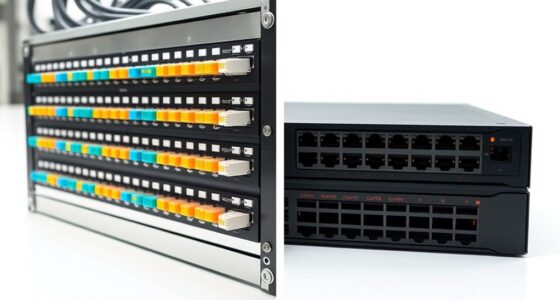Just as a vigilant lighthouse guides ships through foggy waters, AI is transforming how you manage networks. It offers real-time insights, automates routine tasks, and predicts issues before they escalate. This shift isn’t just about technology; it’s about how you guarantee continuous, secure connectivity in an ever-changing digital landscape. The question is, how will these advancements reshape your approach to maintaining a resilient network?
Key Takeaways
- AI enables real-time detection and resolution of network issues, reducing downtime and enhancing user experience.
- Predictive analytics allow proactive network planning, preventing outages before they occur.
- Automation streamlines routine tasks, improving accuracy and freeing human resources for complex problems.
- Advanced threat detection and security features protect networks from evolving cyber threats.
- Overall, AI improves network management efficiency, responsiveness, and decision-making capabilities.

Artificial intelligence is transforming network management by enabling systems to automatically detect, diagnose, and resolve issues in real-time. This shift means you no longer have to rely solely on manual monitoring or reactive troubleshooting. Instead, AI-driven tools continuously analyze network activity, identifying anomalies and potential problems before they impact your users. Automated diagnostics play an essential role here, allowing AI to quickly pinpoint the root cause of issues without human intervention. This speeds up response times considerably, reducing downtime and maintaining a smoother user experience.
Predictive analytics is another key aspect of AI’s influence on network management. By analyzing historical data, AI models can forecast potential network failures or bottlenecks before they happen. This proactive approach helps you plan maintenance windows, allocate resources more efficiently, and prevent outages altogether. With predictive insights, you gain a deeper understanding of your network’s behavior, making your management strategies more strategic and less reactive. This not only minimizes disruptions but also optimizes overall network performance.
As you adopt AI, you’ll notice that routine tasks such as configuring network devices, updating security protocols, and monitoring traffic become more streamlined. AI systems can automate these processes, freeing up your time for more complex issues that require human judgment. For example, AI can automatically adjust bandwidth allocations based on usage patterns or reroute traffic during peak times, ensuring consistent service quality. This automation reduces the likelihood of human error and enhances the network’s resilience.
Moreover, AI enhances security management by continuously scanning for vulnerabilities and detecting suspicious activities. Machine learning algorithms learn from evolving threats, enabling your network to stay one step ahead of cyberattacks. When suspicious activity is detected, AI can alert you immediately or even take automated defensive actions, like blocking malicious IP addresses or isolating compromised devices. This real-time threat mitigation helps protect sensitive data and maintain trust with your users.
In essence, AI empowers you to manage networks more efficiently, predictively, and securely. It automates routine diagnostics and leverages predictive analytics to anticipate issues, giving you the edge in maintaining high performance and reliability. As these technologies continue to evolve, your ability to respond swiftly and accurately to network challenges will only improve, making AI an indispensable tool in modern network management. Additionally, integrating advanced analytics can further enhance the predictive capabilities of your network systems, leading to better-informed decision-making.
Frequently Asked Questions
How Does AI Handle Network Security Threats?
AI handles network security threats by actively monitoring your network for anomalies using advanced detection algorithms. When it spots unusual activity, it quickly assesses the threat and initiates threat mitigation measures to prevent potential breaches. This real-time response minimizes damage, keeps your network secure, and reduces the need for manual intervention. You benefit from faster threat detection and more effective protection, ensuring your network stays safe against evolving cyber threats.
Can AI Predict Future Network Failures Accurately?
Think of AI as your network’s crystal ball, offering a glimpse into potential future failures. With predictive analytics and anomaly detection, it can forecast issues before they strike, often with impressive accuracy. While it’s not perfect, AI helps you stay ahead of problems, catching warning signs early and reducing downtime. You can trust its insights to keep your network running smoothly, like a vigilant guardian watching over your digital domain.
What Are Ai’s Limitations in Network Management?
AI’s limitations in network management include data bias, which can skew insights and decisions, and decision opacity, making it hard for you to understand how AI reaches conclusions. This can lead to misplaced trust or overlooked issues. Additionally, AI struggles with handling novel problems or rare failures, so you still need human oversight to guarantee your network’s stability and security.
How Do Organizations Train AI for Network Tasks?
Think of training AI for network tasks as planting a garden. You provide the seeds—your data training—and nurture it with quality information. You use machine learning algorithms to help the AI recognize patterns and adapt. By feeding it diverse, representative data, you make certain it grows smarter and more reliable. Continuous learning and fine-tuning turn raw data into a well-tended AI that keeps your network running smoothly.
What Is the Cost Impact of Implementing AI Solutions?
Implementing AI solutions impacts your costs through initial investments in technology, training, and infrastructure. Conduct a thorough cost analysis to understand these expenses and compare them to potential savings. ROI assessment helps you gauge the long-term benefits, like reduced operational costs and improved network efficiency. While upfront costs are significant, the efficiencies gained often lead to a favorable return, making AI a worthwhile investment for your network management.
Conclusion
Just as Icarus soared toward the sun, embracing the power of AI elevates your network management to new heights. With real-time insights and automated fixes, you’re no longer bound by traditional limits but empowered to foresee and prevent issues before they escalate. Embrace this technological leap, and like Daedalus’s wings, AI propels you toward a more resilient, efficient, and secure network — a future where challenges are met with agility and confidence.







